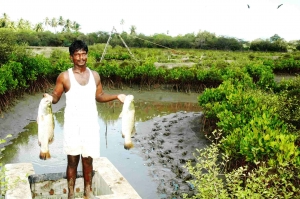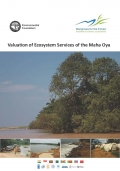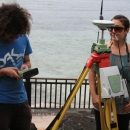Generating and applying knowledge in MFF projects
Case studies of how MFF projects generate and apply knowledge
Location: Asia Region.
It is well recognized that coastal management planning and implementation must be based on sound knowledge and understanding of an area; the ecological, biophysical, socio-economic conditions, knowledge of the political and cultural setting, and on the prevailing governance systems and that knowledge comes from many different sources and including traditional/indigenous and experiential knowledge as well as scientific research.
Coastal managers frequently do not have access to the kind of information, knowledge and expertise essential for good coastal management practice and policy influence. Gaps in capacity, knowledge, and empowerment among coastal ecosystems managers and users, results in conservation and development efforts which fail to maximize positive social, economic, and ecological impacts. Likewise, unequal participation and benefit sharing among civil society groups in costal conservation and development decision-making causes increasing inequity among coastal populations.
Providing coastal managers at all levels with access to sound ecological, biophysical and socio-economic information, and knowledge and expertise for good coastal management practice and policy influence is at the heart of the MFF goal and objective of generating and applying knowledge. In practice, MFF works in a number of ways including building capacity and knowledge through project implementation (particularly in monitoring, learning and evaluation [MLE] and project reporting); scientific research for management (by organizing regional scientific symposia that address regional coastal management issues); and sharing knowledge and experience though the NCB networks (including exchange visits between countries and/or project sites).
What follows are case studies on how MFF generates and applies knowledge from its projects.
“Sustainable freshwater aquaculture in the mangrove-dominated Indian Sundarbans, India” (Sundarbans, West Bengal, India)
This project demonstrates a management model that addresses restoration of ecological services in degraded coastal habitat areas, while integrating coastal ecosystem values into project planning and appraisal.
This Small Grant Facility project examined the protein content of salt marsh grass with a view to developing an eco-friendly, nutritious feed for freshwater prawns. The project successfully used science to enhance traditional aquaculture practices. By demonstrating improved productivity and pond health from using the new floral feed, the project won support from local prawn farmers. At the same time, the new feed enhanced water quality, which will in turn protect the existing mangrove habitat and help stabilize mudflats. Prawns reared on floral feed also exhibited greater weights and redder coloring (both attributes with high consumer appeal), and grew more quickly than prawns fed with commercial feeds.
“Sustainable coastal livelihoods through Integrated Mangrove Fishery Farming Systems (IMFSS)” (Tamil Nadu, India)
This project demonstrates a management model that addresses the restoration of ecological services in degraded coastal habitat areas, while designing ecological and socio-economically sound coastal rehabilitation.
This Small Grant Facility project sought to create awareness among local communities and other stakeholders of the need for alternative or additional income-generating activities based on natural resources, and to demonstrate a brackish water and mangrove-based farming system for wider replication. The IMFFS farms work on the principles of ecological and environmental sustainability. They are fed by tidal water, making pumps unnecessary. Tidal flows also bring in natural feeds and new fish and prawn seed, and flush away wastes. Both IMFFS models had a very high mangrove survival rate (92%). Also encouraging were survival rates for introduced tiger prawn seed and mullet and sea bass fingerlings (60%). In all, 94 community members (including 36 women), and 21 state and central government staff, developed their capacity for IMFFS through workshops and exposure visits.
“Coastal development and ecosystem modeling as a tool to enable improved local and national policy and decision-making processes” (Mahe and Denis Islands, Seychelles)
This project demonstrates a management model that addresses improvement of the knowledge base for coastal planning, policy and management. It also promotes ecological and socio-economic assessment and monitoring as a fundamental component to government impact assessment processes.
This Large Grant Facility project sought to establish a baseline and context for the development, assessment and approval of coastal development in local communities. Based on the baseline information generated in coordination with the Ministry of Environment’s Environmental Impact Assessment (EIA) division, new toolkit for developers was created to simplify EIA procedures in reporting threats to biodiversity in potential development projects. A digitized EIA report tool was also generated for the Ministry to facilitate ease of capturing information from EIA field visits.
“Increasing the resilience of coastal and riverine communities to climate change and other threats, by conserving the ecosystems of the Maha Oya and associated coastal wetlands in Sri Lanka” (North Western Province, Sri Lanka)
This project demonstrates a management model that also addresses improvement of the knowledge base for coastal planning, policy and management, and supports policy-level decisions related to land and resource management.
This Large Grant Facility project completed a comprehensive scientific study of the effects of sand mining on the Maha Oya river, as part of an ongoing advocacy to stop rampant sand mining along the river. After the study was completed, a copy of the report was submitted as references to the legal proceedings (filed at the Supreme Court) as well as to the Geological Survey and Mines Bureau (GSMB), the government agency mandated to regulate sand mining activities along the Maha Oya. As a result, after the GSMB has incorporated the scientific findings into its monitoring processes, new sand mining regulations were agreed upon, and introduced into the process of releasing new mining licenses.

Sea bass harvested from IMFFS farm, Tamil Nadu, India © MSSRF, 2007
Related Documents

Valuation of the ecosystem services of the Maha Oya
Report from a Large Grants Facility of MFF
Author: Manishka De Mel and Chamila Weerathunghe
Publisher: Environmental Foundation
Posted on: 5th Jul 2013
Category:
Size: 1.2 MB

